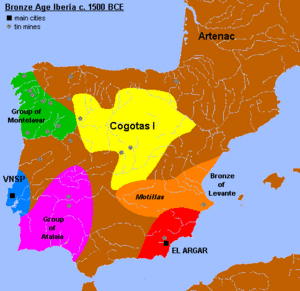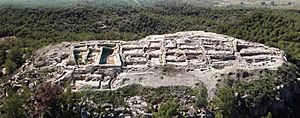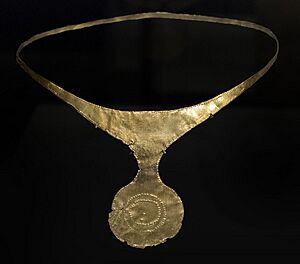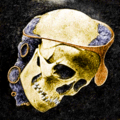Argaric culture facts for kids
 |
|
| Geographical range | Southeast Spain |
|---|---|
| Period | Bronze Age |
| Dates | c. 2200 — c. 1300 BC |
| Major sites | El Argar, La Bastida de Totana |
| Preceded by | Bell Beaker culture, Millaran culture |
| Followed by | Motillas, Bronze of Levante, Post-Argar, Cogotas culture |
The Argaric culture was an important group of people who lived in the Early Bronze Age. They lived in what is now southeastern Spain, mainly in the province of Almería. This culture is named after a key place called El Argar, near the town of Antas. The Argaric culture was active from about 2200 BC to 1550 BC.
These people were among the first in their area to use bronze. This new metal gave them an advantage over other groups who were still using Copper Age tools. The Argaric people were also very skilled at making pottery and ceramic items. They traded these goods with other groups around the Mediterranean Sea.
Their civilization grew and spread further north than the cultures before them. They were very good at mining and working with metals. They dug up bronze, silver, and gold. Then, they used these metals to create strong weapons and beautiful jewelry.
Scientists have studied ancient plant remains (called pollen analysis) from the Sierra de Baza mountains. This research suggests that the Argaric people might have used up too many natural resources. For example, they burned down many oak forests, leaving behind a layer of ash. These forests were replaced by plants that grow in dry, rocky areas, like garrigue and maquis. This overuse of resources might have played a part in their culture's decline.
Contents
Where Did the Argaric Culture Live?
The Argaric culture spread across a large area in southeastern Spain. They built many towns and settlements.
Important Argaric Towns
Here are some of the main towns and sites where the Argaric people lived:
- El Argar: This was a large, irregularly shaped town.
- Fuente Vermeja: A small, fortified site located near El Argar.
- Lugarico Viejo: A larger town very close to Fuente Vermeja.
- La Bastida de Totana: This was a very large and strongly fortified town.
- La Almoloya (Pliego, Murcia): This town was built on top of a high plateau.

- Puntarrón Chico: Located on a small hill near Beniaján (Murcia).
- Ifre (Murcia): Built on a rocky hill.
- Zapata (Murcia): A fortified town, not far from Ifre.
- Cabezo Redondo (Villena, Alicante): One of the biggest settlements, found on a rocky hill next to an old lagoon.
- Gatas (near Mojácar, Almería): A fortified town on a hill. It had impressive water systems.
- El Oficio (near Villaricos, Almería): This town was on a well-protected hill, especially strong towards the sea.
- Cerro de las Viñas, Coy, Spain
- Fuente Álamo (near Cuevas de Almazora, Almería): The main fortress was on a hill, with houses built on terraces down its southern side.
- Almizaraque (Almería): A town that was also used by the earlier Los Millares civilization.
- Cerro de la Virgen de Orce (Granada).
- Cerro de la Encina (Monachil, Granada).
- Cuesta del Negro (Purullena, Granada).
What Did They Make?
The Argaric people created many different items, showing their skills and way of life.
Glass Beads
One special item they made was glass beads. These beads were blue, green, and white. Similar beads have been found in places like Egypt (Amarna), Mycenaean Greece, and Britain (Wessex culture). This suggests that the Argaric people might have traded with distant lands. Some glass beads have even been found in older sites, hinting that this material might have arrived in southeastern Spain earlier than thought.
Other Goods They Produced
- Pottery: Their pottery changed a lot. They stopped decorating it as much and created new shapes and types of pots.
- Textiles: Making cloth was important. They often worked with wool and flax fibers.
- Baskets: Basket-making was also a key skill. They made many different kinds of baskets, more varied than in earlier times.
How Did They Bury Their Dead?
The Argaric people had unique ways of burying their dead, which were different from earlier cultures in the area.
Before the Argaric culture, people often buried many individuals together in large tombs, like the tholos (a type of beehive-shaped tomb). But the Argaric people started burying individuals separately. They often used small stone boxes called cists. These cists were placed either under their homes or outside. This new way of burial seems to have come from the Eastern Mediterranean, possibly from Mycenaean Greece.
Later in the Argaric civilization, they started burying people in large jars called pithoi. This is known as jar-burials. This custom also seems to have come from Greece, where it was used after 2000 BC. However, this jar burial custom did not spread much beyond the Argaric area in Iberia.
Related Cultures
The Argaric culture was connected to or influenced by several other cultures:
- Los Millares: This was an earlier culture that came before the Argaric people.
- Bell Beaker culture: Another earlier culture that influenced the Argaric.
- Bronze of Levante: This culture lived in the Land of Valencia. Their towns were smaller, but they were very similar to the Argaric culture.
- Motillas (La Mancha): These were fortified settlements that might have been military outposts of the Argaric people.
- Cogotas culture: This culture was influenced by the Argaric.
- South-Western Iberian Bronze circle: A group of cultures in the southwest of Iberia.
- Mycenaean Greece: There was clear cultural exchange across the Mediterranean Sea. The Argaric people adopted Greek burial customs, while the Greeks also used the Iberian tholos for burials.
- Nuragic civilization: This culture on the island of Sardinia was likely influenced by the Argaric people, especially with their tholos tombs.
Images for kids
-
Silver diadem from La Almoloya.
See Also
 In Spanish: Cultura argárica para niños
In Spanish: Cultura argárica para niños
- Vila Nova de Sao Pedro
- Prehistoric Iberia
- Treasure of Villena
- Unetice culture
- Bronze Age Britain
- Bell Beaker culture




















